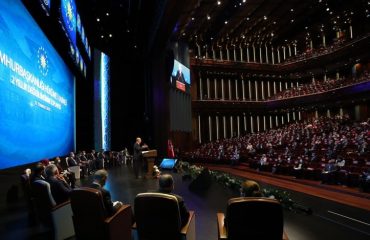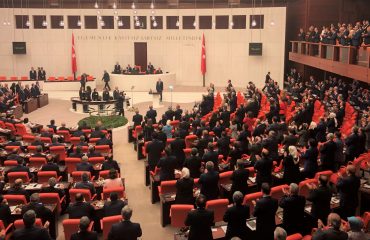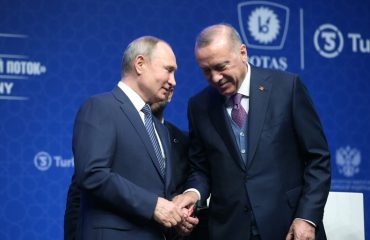Six American soldiers as the first group of reportedly 90 strong troops arrived at the Şanlıurfa airport, neighbouring Syria on August 13, as a part of a Joint Task Force with the Turkish military to examine the establishment of a “Safe Zone” on the Syria side of the border. Such a Safe Zone has been demanded from the American administration by the Turkish government since 2012 and is supposed to prevent the formation of a Kurdish autonomous zone next to Turkish borders by Kurdish militants collaborating with the American forces against ISIS since 2014.
The issues were among the main rifts between the two NATO members along with Turkey’s purchase of the Russian S-400 missiles; the American blocking of the delivery of jointly produced F-35 jets to Turkey whilst Islamist preacher Fethullah Gülen continued his residence in the U.S. despite being indicted of masterminding the 2016 military coup attempt in Turkey against President Tayyip Erdoğan.
Following months-long talks between the delegations and after a statement by Erdoğan that Turkey was planning to stop the activities of the outlawed Kurdistan Workers Party (PKK) in Syria “with or without the U.S.” as endorsed by the months-long military build-up along the Syrian border, Turkish Defense Minister Hulusi Akar said on August 7 that there was an agreement to set up a joint group to work on a safe Zone. That statement was later on seconded by the U.S. Secretary of state Mike Pompeo. Pompeo’s Special Syria Envoy (and former U.S. Ambassador to Ankara) James Jeffrey played an important role in the deal.
Turkey wants a 30-35 km deep and around 140 km long (the Turkish-Syrian border being 913 km) zone to be under the joint patrol of Turkish and American troops to stop any possible attack by PKK- affiliate groups to the Turkish soil; no heavy weapons would be permitted in the zone (as it was the U.S. which armed and trained the militants) and the Syrian refugees in Turkey who used to live in those towns and villages before the civil war broke in 2011 would gradually return. The depth of the zone is the most difficult part of the talks as it covers the M-4 state road in Syria from Aleppo through to the Iraqi border laid parallel to the Turkish border, as the main route to connect the PKK headquarters in Iraq’s Kandil Mountains to the Syrian areas controlled by PKK-affiliate groups protected by the U.S. At one point in the summer of 2018, when Erdoğan had signaled that Turkish troops could hit the PKK in Syria, U.S. President Donald Trump had tweeted that such a move could “devastate” the Turkish economy, causing a currency crisis in the country.
The American central Command (CENTCOM) has been using the People’s Protection Units (YPG) militants as the ground force against the ISIS presence in Syria in the East of River Euphrates; thanks to their legionary fight it was possible for the CENTCOM to clear cities like Raqqa from the ISIS forces. The YPG is the armed wing of the Democratic Union Party (PYD) in Syria and is nothing but the Syrian branch of the PKK, which is designated as a terrorist organization by the U.S. government. It was, after all, the CIA which helped Turkey’s intelligence agency MIT in the arrest of PKK’s leader Abdullah Öcalan back in 1999. The YPG is the backbone and the mass of the Syrian Democratic Forces (SDF) which is merely a PR rebranding as it was admitted by an American general, Raymond Thomas in 2017.
The Safe Zone talks are seen by both the Turkish and the American officials as a way to decrease the tension in-between and to provide some time for diplomatic maneuvering for the S-400/F-35 crisis; it could also help find ways to boost trade, as an incentive for a reconciliation.
Yet there are questions asked by Turkish parties to President Erdoğan, including his main ally in Turkish politics, Devlet Bahçeli of the Nationalist Movement Party (MHP): was this deal “another delay tactic” by the U.S.? Turkish Foreign Minister Mevlüt Çavuşoğlu responded to such questions, stating that Turkey would not let a delay this time and was determined to clear “East of Euphrates” from YPG/PKK “with or without the cooperation of the U.S.” Ankara calculates that the U.S. Administration would not sacrifice its strategic interests from Turkey to tactical interests from PKK- affiliate groups and would not get into a clash with Turkish soldiers to protect PKK-affiliate militants, as the presence of ISIS in Syria is about to diminish.
The question is whether the U.S. is really ready to stop the Kurdish state enthusiasm of the PKK and the Bashar al-Assad regime as supported by the Russian President Vladimir Putin has already called on them to “return to their flanks”, as Russia has already signaled support for a Kurdish federation in the future “new Syria”. The American efforts to divide the PKK and support the pro-American and pro-Israeli Syrian branch under the name of PYD, SDF or some other name sounds naive, as the PKK chiefs excel in distraction, including creating and dissolving brand names.
The ironical part of the story is that American soldiers have now set foot on Turkish soil with the permission of President Erdoğan. Apart from their presence, whether symbolic on both sides of the Turkish-Syrian border, having American soldiers on Turkish soil to invade Iraq was the main reason of the Turkish parliament when rejecting a motion by Erdoğan’s Justice and Development Party (AKP) government in 2003 as some AKP deputies had joined the opposition.
The question which remains unanswered for now is whether the American soldiers in Turkey are really there to start a joint struggle to stop the PKK from its attacks and plans of creating a Kurdish state next to Turkey or just to play with time to soothe Erdoğan who is actually looking to redefine Turkey’s relations with the U.S. and the west in general.
Made with ♥ by tbtcreative.com © 2022 yetkinreport.com All rights reserved.
Yetkin Report · Help · User Agreement · Legal


